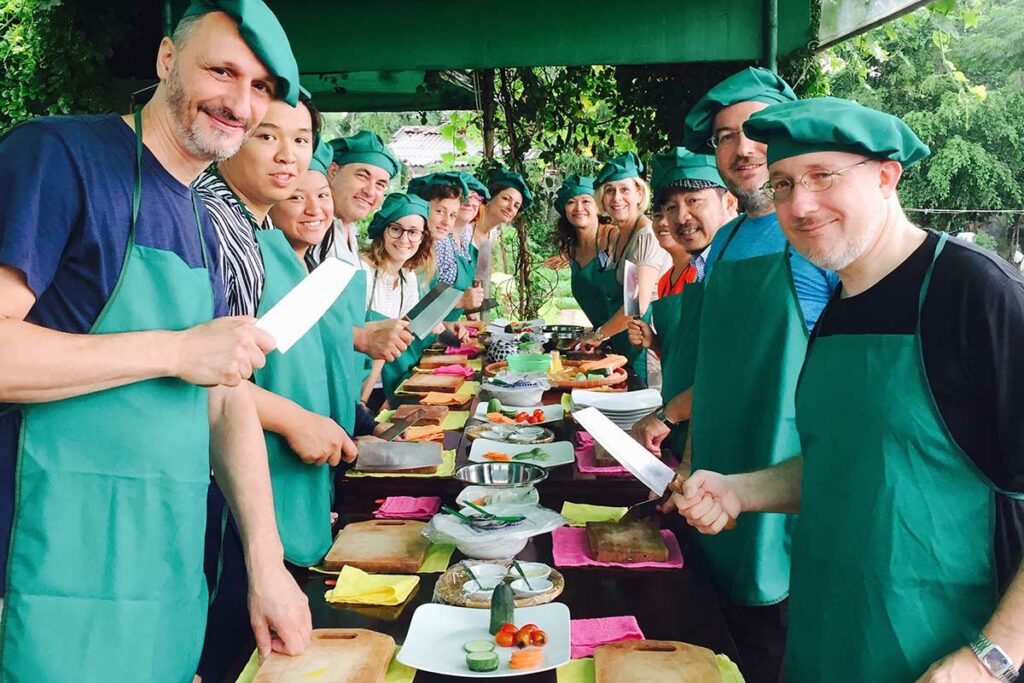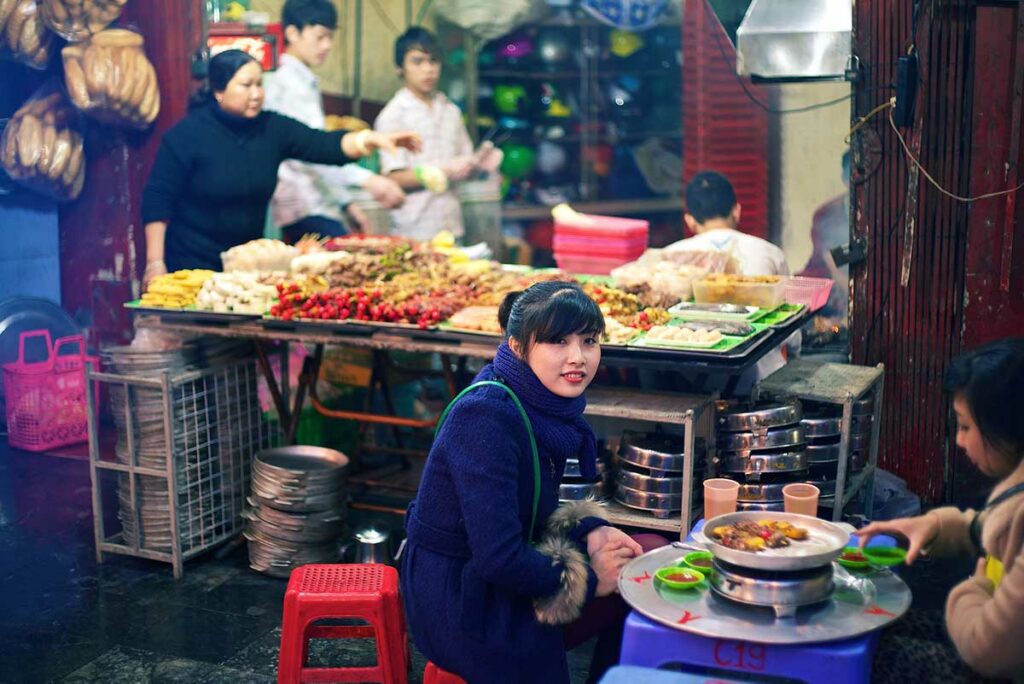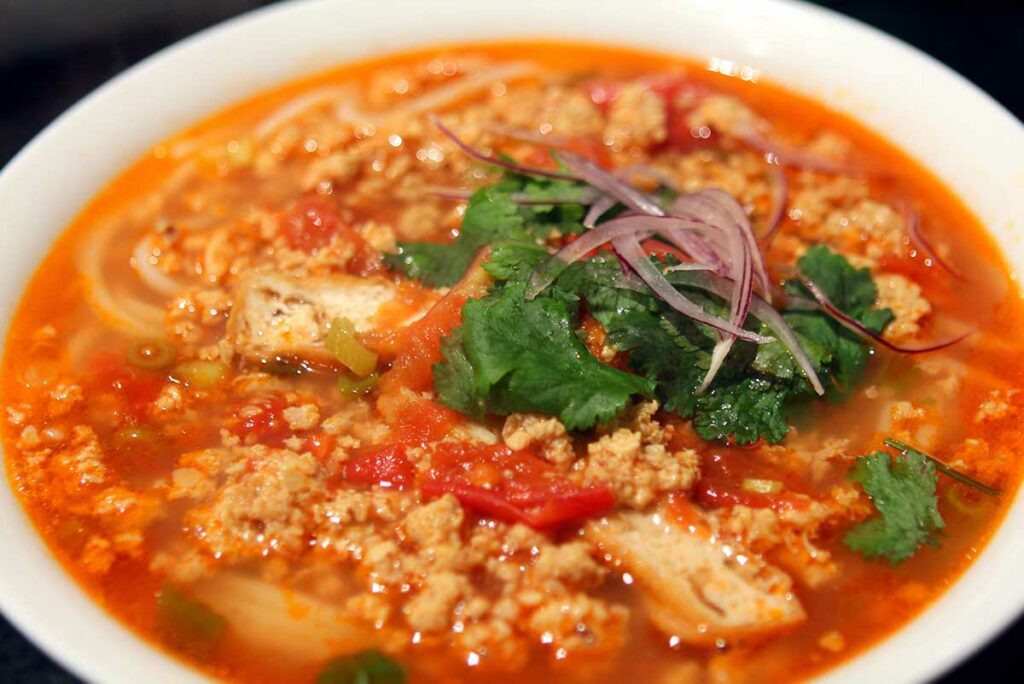Vietnamese food is a vibrant and diverse culinary tradition that offers a delightful array of flavors and dishes. With a rich history and influences from neighboring countries, Vietnamese food showcases a unique balance of flavors and ingredients. From street food stalls to upscale restaurants, the Vietnamese take pride in their food etiquette, emphasizing communal dining and sharing. It’s important to note the focus on hygiene and food safety, as well as the regional variations found throughout Vietnam, each with its own specialty dishes. Exploring the local street food scene and trying dishes like phở, bánh mì, and bún chả are must-try experiences for any food enthusiast.
- Vietnamese Cuisine & ingredients
- Vietnamese food etiquette
- Hygiene and food safety
- Street food
- Vegetarian food
- Vietnamese food in different regions
- Useful words for ordering Vietnamese food
- Best Vietnamese food dishes to try
Vietnamese cuisine & ingredients
Vietnamese cuisine is known for its diverse flavors and fresh ingredients. Key ingredients like fish sauce, rice, herbs, and tropical fruits are commonly used. Vegetables play a significant role in Vietnamese dishes, with an emphasis on freshness. Unlike some other Asian cuisines, Vietnamese food is generally not spicy, allowing the natural flavors of the ingredients to shine through.
Vietnamese cuisine boasts unique culinary techniques that contribute to its distinct flavors. One such technique is “nuoc mam,” the fermentation of fish sauce, which adds a savory depth to many dishes. Another technique is “nuoc cham,” a dipping sauce made from lime juice, fish sauce, sugar, and chili, providing a balance of sweet, sour, and savory flavors.
Vietnamese cuisine has also been influenced by other countries like China and France, evident in dishes such as “banh mi” (French-inspired baguette sandwiches) and “pho” (noodle soup with Chinese origins). These influences have shaped Vietnamese cuisine into a harmonious blend of flavors and cooking styles.
10 ways to experience Vietnamese food
1. Take street food tour
Embark on a street food tour to taste a variety of local dishes and explore the vibrant culinary scene.
2. Join a cooking class

Take part in cooking classes to learn how to prepare Vietnamese dishes and gain insights into the ingredients and techniques.
3. Visit local markets

Visit local markets to witness the hustle and bustle, interact with vendors, and discover fresh produce and ingredients.
4. Try Vietnamese coffee
Indulge in the unique flavors of Vietnamese coffee, both hot and iced, and savor the rich and aromatic brew.
5. Family dinner with ethnic minority

Immerse yourself in the culture by joining a family dinner with an ethnic minority family to experience their traditional dishes and hospitality.
6. Go fruit picking

Venture to the Mekong Delta and participate in fruit picking activities, where you can pluck fresh and tropical fruits from the orchards.
7. Eat at Local restaurants
Explore local restaurants, from hole-in-the-wall establishments to renowned eateries, to taste authentic Vietnamese cuisine and regional specialties.
8. Enjoy signature dishes
Travel across different regions of Vietnam and try their signature dishes, such as phở in Hanoi, bánh xèo in the central region, and Cao lầu in Hoi An.
9. Go out with locals
Engage with locals and seek their recommendations for hidden gems and lesser-known food spots for a truly authentic experience.
10. Food events
Join food festivals or events that celebrate Vietnamese cuisine, where you can indulge in a variety of dishes, enjoy live music, and soak up the festive atmosphere.
Vietnamese food etiquette

1. Chopstick basics: When using chopsticks, it’s polite to hold them correctly and avoid sticking them upright in a bowl of rice. Instead, rest them on a chopstick rest or lay them across the edge of your plate.
2. Sharing is caring: Vietnamese meals often involve sharing dishes. Embrace the communal spirit and try a little bit of everything. Use serving spoons or chopsticks to transfer food from shared dishes to your own plate.
3. Slurping is okay: In Vietnamese culture, it’s acceptable and even considered a compliment to slurp noodles or soup. So don’t be shy about making some noise while enjoying your pho or bun bo Hue!
4. Toasting traditions: When drinking with Vietnamese locals, it’s customary to make a toast by saying “mot, hai, ba, yo!” (meaning “one, two, three, cheers!”). Maintain eye contact and clink glasses with others, showing respect and friendship.
Hygiene and food safety
When visiting Vietnam, it’s essential to prioritize hygiene and food safety to ensure a healthy and enjoyable experience:
1. Opt for boiled or cooked foods: Eating boiled or properly cooked foods can significantly reduce the risk of consuming harmful bacteria or parasites. Avoid raw or undercooked meats, seafood, and eggs, as they may contain pathogens.
2. Clean fruits and vegetables thoroughly: Wash fresh fruits and vegetables with clean water before consuming or peeling them. This helps remove any dirt, pesticides, or bacteria present on the surface.
3. Choose reputable food establishments: Look for places where you see a high number of locals dining. This indicates that the food is likely to be good and the turnover is high, reducing the chances of food sitting around for too long.
4. Avoid tap water: It is best to refrain from drinking tap water, as it may be contaminated. Stick to bottled water or use water purification methods like boiling or using water purification tablets.
5. Take precautions for stomach problems: It’s a good idea to carry over-the-counter medications or remedies for stomach problems, such as antacids or anti-diarrheal medication. These can help alleviate symptoms in case of any gastrointestinal discomfort.
Street food in Vietnam

Vietnam is renowned for its vibrant street food culture, with an abundance of food stalls lining every street. The variety of dishes available is staggering, offering an affordable and delicious culinary adventure. While language barriers and concerns about hygiene can be daunting, joining a street food tour led by a local guide is an excellent way to safely explore the best food spots, ensuring proper hygiene practices and providing insights into the city’s local customs. These tours not only satisfy your taste buds but also offer a deeper understanding of Vietnamese cuisine and the confidence to venture out and explore street food on your own.
Vegetarian food in Vietnam
Vegetarian food in Vietnam has gained popularity in recent years, fueled by the growing number of tourists and the preferences of the younger generation. With the influence of Buddhism, which promotes vegetarianism, many Vietnamese dishes offer delicious meat-free options. Common words used for vegetarian dishes include “chay” (vegetarian) and “com chay” (vegetarian rice). As awareness of vegetarianism spreads, more restaurants and street food vendors are offering a wide variety of flavorful and satisfying vegetarian options to cater to the increasing demand.
Vietnamese food in different regions
Vietnamese food varies significantly across different regions, with each region having its own unique dishes and cooking styles. In North Vietnam, the food tends to have stronger flavors, often utilizing ingredients like shrimp paste and fermented sauces. In contrast, South Vietnamese cuisine leans towards more natural and lighter flavors, emphasizing the use of fresh herbs and vegetables.
However, the culinary diversity extends beyond the North and South divide. Different towns and areas within Vietnam may have their own signature dishes or distinctive ways of preparing certain dishes, adding further depth to the country’s gastronomic landscape. Exploring the regional food is a popular activity for Vietnamese locals and travelers alike, as it allows them to experience the diverse flavors and culinary traditions across the country.
For example, the city of Hue, the former imperial capital of Vietnam, has a cuisine influenced by its royal heritage. The food here is not only about taste but also about presentation, with dishes often crafted to look exceptionally beautiful or even resembling royal cuisine. This attention to aesthetics reflects the city’s rich cultural history and traditional values.
In summary, Vietnamese cuisine is a tapestry of regional flavors and culinary techniques, with each region, town, and even neighborhood contributing its own unique dishes and cooking traditions. Exploring the local food scene is a delightful way to uncover the diverse culinary heritage of Vietnam.
Useful words for ordering Vietnamese food
When visiting Vietnam, it’s helpful to familiarize yourself with some useful words for ordering food. Whether you’re navigating a menu or communicating with street food vendors, knowing some words will help your dining experience and allow you to savor the diverse flavors of Vietnamese cuisine.
- Thank you – “Cám ơn” (pronounced: kahm uhn)
- It tastes good – “Ngon quá” (pronounced: ngon kwah)
- Can I have a fork? – “Có thìa không?” (pronounced: koh tee-ah kohng)
- Can I have a spoon? – “Có muỗng không?” (pronounced: koh moo-uhng kohng)
- Can I have chopsticks? – “Có đũa không?” (pronounced: koh doo-ah kohng)
- Can I have some water? – “Có thể có nước không?” (pronounced: koh teh koh nook kohng)
- Delicious – “Ngon” (pronounced: ngon)
- Spicy – “Cay” (pronounced: kai)
- Không cay – Not spicy (pronounced: kohng kai)
- Sweet – “Ngọt” (pronounced: ngut)
- Bill, please – “Tính tiền” (pronounced: ting tyen)
- Chay – Vegetarian (pronounced: chay)
- Cá – Fish (pronounced: kah)
- Gà – Chicken (pronounced: gah)
- Heo – Pork (pronounced: heh-oh)
- Bò – Beef (pronounced: boh)
- Không đá – No ice (pronounced: kohng dah)
- Rau – Vegetables (pronounced: rao)
- Rau sống – Raw vegetables (pronounced: rao sohng)
- Rau luộc – Boiled vegetables (pronounced: rao lohk)
- Cơm – Rice (pronounced: kohm)
- Bánh mì – Bread (pronounced: banh mee)
- Mì – Noodles (pronounced: mee)
- Hành – Onion (pronounced: hahn)
- Hành tây – Onion (pronounced: hahn tai)
- Tỏi – Garlic (pronounced: toy)
- Đậu hũ – Tofu (pronounced: daow hoo)
- Chấm muối tiêu – Salt and pepper dipping sauce (pronounced: chahm mwoy tee-ow)
- Nước mắm – Fish sauce (pronounced: nook mam)
- Nước chấm – Dipping sauce (pronounced: nook chahm)
- Trái cây – Fruits (pronounced: try kai)
- Nước suối – Bottled water (pronounced: nook su-oy)
- Gỏi – Salad (pronounced: goy)
- Cuốn – Fresh spring rolls (pronounced: coon)
- Xôi – Sticky rice (pronounced: soy)
Best Vietnamese food dishes to try
Here’s a list of 15 delicious Vietnamese dishes to try:

Phở – Traditional Vietnamese noodle soup with various meat options.

Bánh mì – Crusty baguette filled with savory ingredients like grilled meat, pâté, and pickled vegetables.

Gỏi cuốn – Fresh spring rolls filled with shrimp, herbs, and vermicelli noodles.

Bún chả – Grilled pork served with rice vermicelli noodles and fresh herbs.

Cá kho tộ – Caramelized fish in clay pot, often served with steamed rice.

Bánh xèo – Crispy rice flour crepes filled with pork, shrimp, bean sprouts, and herbs.

Bún bò Huế – Spicy beef noodle soup with lemongrass and chili.

Cơm tấm – Broken rice topped with grilled pork, egg, and pickled vegetables.

Chả giò – Fried spring rolls with a crispy exterior and flavorful filling.

Bánh cuốn – Steamed rice rolls filled with minced pork and mushrooms, served with dipping sauce.

Bún riêu cua – Crab and tomato soup with vermicelli noodles and crab meat.

Hủ tiếu – Pork-based noodle soup with various toppings like shrimp, pork, and quail eggs.

Bánh canh – Thick and chewy rice noodle soup with various meat or seafood options.

Bánh bao – Steamed buns filled with pork, mushrooms, and eggs.

Chè – Sweet dessert soup or pudding made with beans, fruits, and coconut milk.

